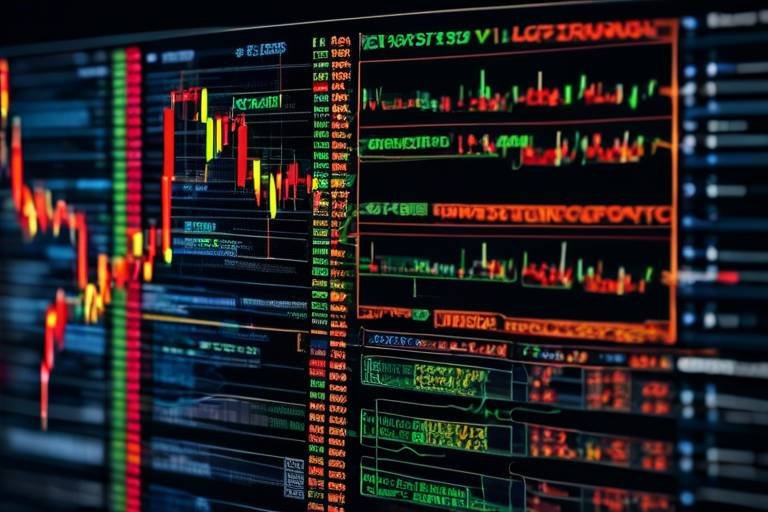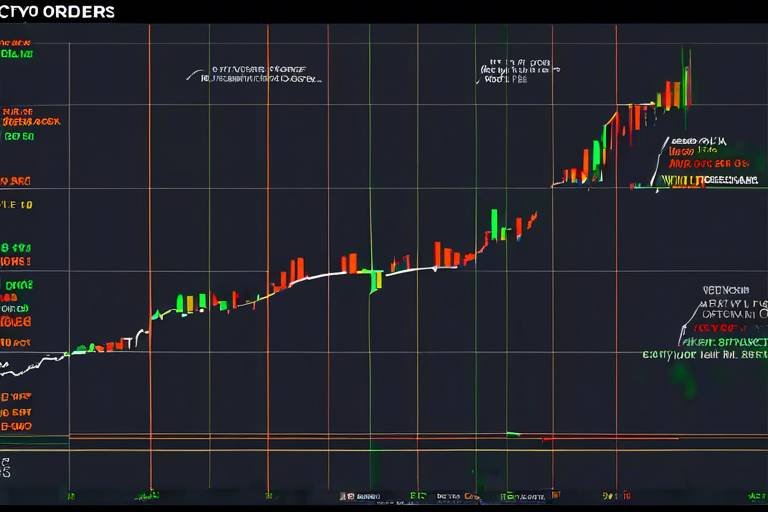Understanding the Basics of Market Depth Analysis
Market depth analysis is a fundamental concept that every trader should grasp if they want to navigate the complex waters of financial markets effectively. But what exactly is market depth? At its core, it refers to the market's capacity to handle substantial buy or sell orders without causing significant price fluctuations. Think of it like a swimming pool: if you throw a small pebble, the ripples will be minimal, but if you toss in a boulder, the waves will be much more pronounced. This analogy highlights the importance of understanding market depth, as it can significantly impact trading decisions and strategies.
So, why should traders care about market depth? The answer lies in the insights it provides into the supply and demand dynamics at play within a market. By analyzing market depth, traders can anticipate potential price movements and make more informed decisions. Imagine walking into a crowded marketplace; you can gauge the popularity of a product by observing how many people are interested in buying it versus how many are selling it. Similarly, market depth allows traders to visualize the balance of buy and sell orders, helping them to predict short-term price fluctuations with greater accuracy.
One of the key aspects of market depth is the bid and ask prices. The bid price represents the highest price a buyer is willing to pay for an asset, while the ask price is the lowest price a seller is willing to accept. The difference between these two prices is known as the spread, and it can indicate the liquidity of the market. A narrower spread often suggests a more liquid market, which is generally more favorable for traders. Understanding these prices is crucial for making timely and profitable trades.
Additionally, the order book plays a significant role in market depth analysis. This real-time list of buy and sell orders provides valuable insights into market sentiment. By examining the order book, traders can identify potential support and resistance levels, as well as gauge the overall mood of the market. For instance, if there are many buy orders stacked at a certain price level, it may indicate strong support, suggesting that prices are unlikely to drop below that level. Conversely, a large number of sell orders can signal resistance, indicating that prices may struggle to rise above that point.
To effectively utilize market depth analysis, traders can leverage various tools and platforms that offer market depth visualization. These tools can help traders make sense of the data and enhance their trading strategies. However, it's important to remember that while market depth analysis is a powerful tool, it is not foolproof. Traders should be aware of its limitations and consider additional factors when making decisions.
In conclusion, understanding market depth analysis is essential for traders looking to improve their decision-making processes. By grasping the concepts of bid and ask prices, the order book, and the dynamics of supply and demand, traders can gain a competitive edge in the market. Just like a seasoned sailor knows how to read the wind and waves, a knowledgeable trader can navigate the complexities of market depth to make informed trading decisions.
- What is market depth? Market depth refers to the market's ability to sustain large orders without significantly affecting the asset's price.
- Why is market depth important in trading? It provides insights into supply and demand, helping traders anticipate price movements.
- What are bid and ask prices? The bid price is the highest price buyers are willing to pay, while the ask price is the lowest price sellers will accept.
- How can I analyze market depth? By using tools and platforms that visualize market depth, traders can better understand market dynamics.
- What are the limitations of market depth analysis? Market manipulation and volatility can distort market depth, leading to inaccurate interpretations.

The Concept of Market Depth
Market depth is a term that often floats around in trading discussions, but what does it really mean? Simply put, market depth refers to the market's capacity to handle large buy and sell orders without causing significant price changes. Imagine you’re at a crowded concert, and everyone is trying to get to the front. If a few people push through, it might cause a bit of chaos, but the crowd can generally absorb that movement without a massive disruption. In trading, market depth operates in a similar way, allowing traders to execute their orders while keeping the price relatively stable.
Understanding market depth is crucial for traders who want to make informed decisions. It provides insights into how many buy and sell orders exist at various price levels, which in turn helps in gauging the supply and demand dynamics of a particular asset. Think of it as a window into the market's psyche—what traders are willing to pay and what sellers are ready to accept. By analyzing this data, traders can predict potential price movements and identify strategic entry or exit points.
To visualize market depth, traders often refer to the order book, which is a real-time list of all outstanding buy and sell orders. The order book allows traders to see where the bulk of orders lie, which can indicate potential support and resistance levels. For instance, if there’s a large number of buy orders at a particular price level, it suggests that the price will likely struggle to fall below that point. Conversely, a significant number of sell orders can act as a ceiling, making it hard for the price to rise above that level.
One of the key components of market depth is the bid-ask spread. The bid price is the highest price a buyer is willing to pay for an asset, while the ask price is the lowest price a seller will accept. The difference between these two prices is known as the spread, and it can provide additional insights into market liquidity. A narrow spread often indicates a liquid market with many participants, while a wider spread can signal lower liquidity and possibly higher volatility.
In summary, market depth is not just a technical term; it’s a fundamental concept that every trader should grasp. By understanding the dynamics of market depth, traders can better navigate the complexities of trading and enhance their decision-making processes. Whether you’re a seasoned trader or a newcomer, keeping an eye on market depth can be the difference between a successful trade and a costly mistake.

Importance of Market Depth in Trading
The importance of market depth in trading cannot be overstated. It serves as a critical indicator of the market's health and liquidity, providing traders with insights that go beyond basic price movements. When traders understand the intricacies of market depth, they gain a powerful tool for making informed decisions. By analyzing the supply and demand dynamics represented in the order book, traders can anticipate potential price movements and adjust their strategies accordingly. This is particularly crucial in fast-paced markets where split-second decisions can lead to significant profits or losses.
One of the primary reasons market depth is vital is that it reveals the balance between buyers and sellers. When there are more buy orders than sell orders, the price is likely to rise, while a surplus of sell orders can lead to a price drop. This understanding allows traders to position themselves advantageously. For instance, if a trader notices a large number of buy orders accumulating at a certain price level, it may indicate strong support, prompting them to consider entering a long position. Conversely, a significant number of sell orders might suggest resistance, signaling a potential exit point.
Moreover, market depth can help traders identify potential price reversals. By observing the order book, traders can spot areas where the supply and demand may shift suddenly. For example, if there’s a sudden influx of buy orders at a specific price level, it could indicate a reversal point, allowing traders to capitalize on the impending price movement. This ability to predict short-term fluctuations is invaluable, especially in day trading scenarios where timing is everything.
Additionally, market depth analysis can enhance risk management strategies. By understanding where the liquidity lies, traders can set more effective stop-loss orders. For instance, placing a stop-loss just below a strong support level identified through market depth can minimize losses during market downturns. This proactive approach not only protects capital but also instills confidence in trading decisions.
However, while market depth provides crucial insights, it’s essential to consider it in conjunction with other analytical tools. Relying solely on market depth can lead to incomplete interpretations. Therefore, traders should integrate market depth analysis with technical indicators and fundamental analysis to form a comprehensive trading strategy.
In summary, the importance of market depth in trading lies in its ability to provide a clearer picture of market dynamics. By analyzing the order book and understanding the balance of supply and demand, traders can make more informed decisions, anticipate price movements, and enhance their overall trading strategies. It’s not just about buying low and selling high; it’s about understanding the market's pulse and responding accordingly.
- What is market depth? - Market depth refers to the market's ability to sustain large market orders without significantly impacting the asset's price.
- How does market depth help traders? - It provides insights into supply and demand dynamics, helping traders anticipate price movements and make strategic decisions.
- What are bid and ask prices? - The bid price is the highest price buyers are willing to pay, while the ask price is the lowest price sellers will accept.
- Can market depth be manipulated? - Yes, market manipulation can distort market depth, leading to false signals. Traders should be cautious and consider additional factors.
- How does volatility affect market depth analysis? - High volatility can rapidly change market depth, complicating analysis for traders seeking stability.

How Market Depth Affects Price Movements
Understanding how market depth affects price movements is akin to grasping the heartbeat of the financial markets. Just like a pulse can indicate the overall health of a person, market depth can reveal the vitality of an asset. Imagine standing in a crowded marketplace; the ebb and flow of buyers and sellers create a dynamic environment where prices can shift dramatically based on demand. In trading, this concept is no different. The balance of buy and sell orders plays a crucial role in determining short-term price fluctuations.
When there are more buyers than sellers, prices tend to rise. Conversely, if sellers outnumber buyers, prices often fall. This relationship is where market depth comes into play. It provides a snapshot of the supply and demand at various price levels, allowing traders to predict potential price movements. For instance, if the market depth shows a significant number of buy orders at a certain price level, it might indicate strong support, suggesting that the price could bounce back if it approaches that level.
To illustrate, let’s consider a hypothetical scenario where a stock is trading at $50, and the market depth reveals the following:
| Price Level | Buy Orders | Sell Orders |
|---|---|---|
| $49.50 | 200 | 50 |
| $50.00 | 100 | 150 |
| $50.50 | 50 | 200 |
In this table, we can observe that at $49.50, there are significantly more buy orders (200) compared to sell orders (50). This suggests that if the price were to drop to $49.50, there would be considerable buying interest, which could prevent the price from falling further. On the other hand, at $50.50, the sell orders outnumber the buy orders, indicating potential resistance if the price attempts to rise.
Such insights from market depth allow traders to make more informed decisions. They can identify key levels of support and resistance, which are critical in crafting a trading strategy. However, it’s essential to remember that market depth is not static; it can change rapidly based on market sentiment and external factors. Therefore, traders must remain vigilant and continuously analyze the order book to adapt to the market's pulse.
In summary, market depth serves as a powerful tool for understanding price movements. By analyzing the balance of buy and sell orders, traders can gain valuable insights into market dynamics, enabling them to anticipate price fluctuations effectively. Just as a sailor reads the winds and tides to navigate the seas, savvy traders use market depth to steer their trading decisions in the right direction.
- What is market depth? Market depth refers to the market's ability to sustain large orders without significantly impacting the asset's price.
- How do bid and ask prices relate to market depth? The bid price represents the highest price buyers are willing to pay, while the ask price is the lowest price sellers will accept, both of which are crucial for understanding market depth.
- Can market depth analysis guarantee profits? No, while it provides valuable insights, market depth analysis should be used in conjunction with other tools and strategies to make informed trading decisions.

Bid and Ask Prices Explained
Understanding bid and ask prices is essential for any trader looking to navigate the complex waters of financial markets. At its core, the bid price represents the maximum price that a buyer is willing to pay for an asset, while the ask price is the minimum price that a seller is willing to accept. This fundamental relationship between buyers and sellers is what drives market transactions and ultimately influences price movements.
To put it simply, the bid-ask spread is the difference between these two prices. A smaller spread often indicates a more liquid market, where assets can be bought and sold more easily. Conversely, a larger spread can suggest lower liquidity, making it more challenging to execute trades without affecting the price. For example, if the bid price for a stock is $50 and the ask price is $52, the spread is $2. This spread can serve as a critical indicator of market conditions, as tight spreads often reflect strong demand and supply.
It's also important to note that bid and ask prices are constantly changing, influenced by various factors such as market sentiment, economic news, and overall market volatility. For instance, during periods of high volatility, you might see the bid and ask prices fluctuate rapidly, which can create both opportunities and risks for traders. Understanding these dynamics can empower traders to make more informed decisions.
When analyzing bid and ask prices, traders often look at the order book, which provides real-time data on pending buy and sell orders. This can give traders insights into market sentiment. For example, if there are significantly more buy orders than sell orders at a certain price level, it could indicate that the price may rise, as demand outweighs supply. Conversely, a heavy concentration of sell orders could signal potential downward pressure on the price.
Furthermore, traders often employ various strategies based on bid and ask prices. Some may choose to place limit orders at the bid price to buy a security only when it reaches a specific price point, while others might place orders at the ask price to sell at a desired profit level. Understanding where to position these orders can significantly affect trading outcomes.
In summary, grasping the concepts of bid and ask prices is not just about knowing their definitions; it's about understanding how they interact within the market. By keeping an eye on the bid-ask spread and the order book, traders can gain valuable insights that assist in making informed trading decisions. As you delve deeper into market depth analysis, always remember that these prices are the heartbeat of trading, reflecting the ongoing dance between supply and demand.

Order Book Dynamics
The order book plays a pivotal role in understanding market depth and price movements. It is essentially a real-time ledger that lists all pending buy and sell orders for a particular asset. Imagine it as a bustling marketplace where buyers and sellers are constantly negotiating prices. Each entry in the order book reflects a trader's intention, whether it's to buy at a certain price or sell at a desired rate. By analyzing this dynamic, traders can gauge market sentiment and make more informed decisions.
One of the key aspects of the order book is its structure. It typically consists of two main components: the bid and the ask sections. The bid section displays the highest prices buyers are willing to pay, while the ask section shows the lowest prices sellers are prepared to accept. This creates a visual representation of supply and demand, which is crucial for understanding potential price movements.
To illustrate, let’s consider a simplified example of an order book for a fictional stock:
| Bid Price | Bid Volume | Ask Price | Ask Volume |
|---|---|---|---|
| $100.00 | 50 | $100.50 | 30 |
| $99.50 | 40 | $101.00 | 20 |
| $99.00 | 60 | $101.50 | 10 |
In this table, you can see the highest bid is $100.00 with a volume of 50 shares, while the lowest ask is $100.50 with a volume of 30 shares. The difference between the highest bid and the lowest ask is known as the spread, which indicates the liquidity of the asset. A narrower spread usually suggests a more liquid market, while a wider spread can signal lower liquidity.
Moreover, the order book is not static; it constantly changes as new orders are placed and existing orders are filled or canceled. This fluidity can create opportunities for traders. For instance, if a trader notices a significant imbalance between the bids and asks, it could signal a potential price movement. If there are many more buyers than sellers at a certain price point, it might indicate upward pressure on the price.
However, it’s essential to approach order book dynamics with a degree of caution. Traders should be aware of the potential for market manipulation, where large players might place fake orders to create a misleading picture of supply and demand. This phenomenon, often referred to as spoofing, can distort the true market sentiment and lead to poor trading decisions.
In conclusion, understanding order book dynamics is crucial for any trader looking to enhance their market analysis. By keeping an eye on the bid and ask prices, recognizing the importance of spread, and being aware of the fluid nature of the order book, traders can gain valuable insights that help them navigate the complexities of the market.
- What is an order book? An order book is a real-time list of buy and sell orders for an asset, showing the highest bid prices and the lowest ask prices.
- How does the order book affect trading decisions? By analyzing the order book, traders can gauge market sentiment, identify potential price movements, and make more informed trading decisions.
- What is market manipulation in the context of the order book? Market manipulation refers to practices like spoofing, where traders place fake orders to mislead others about the supply and demand dynamics, potentially distorting the market's true state.

Utilizing Market Depth Tools
In the fast-paced world of trading, having the right tools at your disposal can make all the difference. Market depth tools are essential for traders who want to gain a comprehensive understanding of market dynamics. These tools provide real-time insights into the supply and demand landscape, allowing traders to make informed decisions. But how do you effectively utilize these tools to your advantage?
First and foremost, it's important to choose the right platform. Many trading platforms offer built-in market depth features that display the order book. This visual representation allows you to see the bid and ask prices at a glance, helping you identify potential entry and exit points. For instance, if you notice a significant number of buy orders at a certain price level, it might indicate strong support, while a large number of sell orders could signal resistance.
Moreover, understanding the order book's layout is crucial. The order book displays the limit orders placed by traders, and it typically shows:
| Price Level | Buy Orders | Sell Orders |
|---|---|---|
| $100 | 200 | 50 |
| $101 | 150 | 75 |
| $102 | 100 | 100 |
This table illustrates how traders can gauge market sentiment by observing where the majority of orders are concentrated. If the buy orders significantly outweigh the sell orders at a specific price level, it may suggest bullish sentiment. Conversely, if sell orders dominate, the market might be leaning bearish.
Another important aspect of utilizing market depth tools is the ability to set alerts. Many platforms allow you to set price alerts based on market depth changes. For example, if the price reaches a certain level where a large number of buy orders exist, you can be notified instantly. This feature can be a game-changer, as it keeps you informed without having to constantly monitor the market.
Additionally, some traders prefer using third-party market depth analysis tools that offer advanced features like heat maps and graphical representations of the order book. These tools can help you visualize the market's depth more effectively, making it easier to spot trends and potential reversals. By combining these insights with your trading strategy, you can enhance your decision-making process significantly.
Ultimately, mastering the use of market depth tools requires practice and patience. The more familiar you become with how these tools operate, the better equipped you'll be to interpret the data they provide. Remember, market depth analysis is not just about numbers; it's about understanding the story behind those numbers. So take your time, explore different tools, and find what works best for your trading style.
- What is market depth? Market depth refers to the market's ability to sustain large orders without significantly impacting the asset's price.
- How do market depth tools help traders? These tools provide insights into supply and demand dynamics, helping traders anticipate price movements and make informed decisions.
- Are there any limitations to market depth analysis? Yes, factors like market manipulation and volatility can distort market depth, leading to inaccurate interpretations.

Limitations of Market Depth Analysis
While market depth analysis is an invaluable tool for traders aiming to understand the intricacies of price movements, it is essential to recognize its limitations. Just like a magnifying glass can help you see the fine details of a map, it can also distort your view if you focus too closely. In trading, relying solely on market depth can lead to misguided decisions. One primary limitation is the potential for market manipulation. Unscrupulous traders may place large orders to create a false impression of demand or supply, misleading others into making trades based on distorted data.
Another significant factor to consider is market volatility. During periods of high volatility, the market depth can change rapidly, making it challenging for traders to interpret the data accurately. For instance, imagine trying to catch a fish in a turbulent river; the currents can shift so quickly that your fishing line may not land where you intended. Similarly, in a volatile market, the depth can fluctuate unpredictably, complicating the analysis for traders who are seeking stability.
Additionally, market depth analysis often does not account for external factors that can influence price movements, such as economic news, geopolitical events, or changes in market sentiment. These factors can create sudden price swings that market depth alone cannot predict. Therefore, it is crucial for traders to combine market depth analysis with other tools and indicators to form a more comprehensive view of the market.
To summarize, here are some key limitations of market depth analysis:
- Market Manipulation: Distorted data due to false orders.
- Volatility: Rapid changes in market depth during turbulent times.
- External Influences: Economic and geopolitical factors that impact price movements.
In light of these limitations, traders should approach market depth analysis with a balanced perspective. While it offers valuable insights, it should not be the sole basis for trading decisions. Instead, consider it as one piece of a larger puzzle, integrating it with other analytical methods for a well-rounded trading strategy.
Q: What is market depth analysis?
A: Market depth analysis involves evaluating the supply and demand dynamics of an asset by examining the order book, which lists buy and sell orders at various price levels.
Q: How can market depth analysis improve my trading?
A: By understanding market depth, traders can anticipate price movements and make more informed trading decisions, potentially leading to better outcomes.
Q: What are the risks associated with market depth analysis?
A: Risks include market manipulation, volatility, and external factors that can affect price movements, making it essential to use market depth analysis in conjunction with other tools.
Q: Can I rely solely on market depth for trading decisions?
A: No, it's crucial to combine market depth analysis with other indicators and market research to form a comprehensive trading strategy.

Market Manipulation Risks
Market manipulation is a significant concern for traders who rely heavily on market depth analysis. Imagine walking into a bustling marketplace where sellers are shouting about their goods, trying to attract buyers with enticing offers. Now, what if some of those sellers were actually working together to create a false sense of demand or supply? This analogy perfectly illustrates how market manipulation can distort the true picture of market depth, leading traders astray.
Market manipulation can take many forms, such as spoofing, where traders place large orders with no intention of executing them, only to cancel them before they are filled. This tactic can mislead other traders into believing there is a genuine interest in a particular asset, causing them to react based on false signals. Additionally, there’s wash trading, where a trader buys and sells the same asset simultaneously to create the illusion of high trading volume. Both of these practices can significantly impact market depth and, consequently, your trading decisions.
To navigate these risks effectively, traders should be vigilant and consider a combination of factors when analyzing market depth. Here are a few strategies to keep in mind:
- Cross-Verification: Always cross-check market depth data with other indicators, such as price trends and news events, to ensure a more comprehensive view of the market.
- Time Analysis: Pay attention to the timing of trades. Sudden spikes in volume or unusual activity can be red flags indicating potential manipulation.
- Use of Technology: Leverage advanced trading platforms that offer tools for detecting unusual patterns in market depth, helping you make more informed decisions.
In conclusion, while market depth analysis is a powerful tool for traders, it is essential to remain aware of the risks associated with market manipulation. By adopting a cautious and informed approach, you can enhance your trading strategies and minimize the potential impact of deceptive practices.
Q1: What is market manipulation?
A1: Market manipulation refers to practices that distort the true supply and demand of an asset, often leading to misleading price movements.
Q2: How can I identify market manipulation?
A2: Look for unusual trading patterns, sudden spikes in volume, or discrepancies between market depth and price movements, which may indicate manipulation.
Q3: Can market manipulation affect my trading strategy?
A3: Yes, it can lead to incorrect assumptions about market conditions, potentially resulting in poor trading decisions and financial losses.
Q4: What tools can help in detecting market manipulation?
A4: Advanced trading platforms often have built-in analytics and alerts that can help identify unusual market behaviors, aiding in the detection of manipulation.

Volatility and Market Depth
When we talk about volatility in trading, we're diving into a world where prices can swing wildly, sometimes in a matter of seconds. This volatility can have a profound impact on market depth, which is the backbone of understanding supply and demand in any market. Imagine you're at a bustling marketplace; when the crowd is thick, it can be hard to see what’s happening. Similarly, during periods of high volatility, the depth of the market can shift rapidly, making it challenging for traders to gauge the true state of supply and demand.
In a stable market, traders can rely on market depth to provide a clear picture of where buy and sell orders are stacked. However, when volatility kicks in, this picture can become distorted. Prices can change so quickly that the order book—essentially the list of buy and sell orders—might not reflect the actual market sentiment. It’s akin to trying to read a book in a dimly lit room; the words might be there, but they’re hard to decipher.
During high volatility, the depth of the market may fluctuate dramatically due to the rapid influx and outflux of orders. For instance, if a significant news event occurs, traders may rush to either buy or sell, which can create a sudden spike in buying or selling pressure. This can lead to a situation where the market depth appears shallow, as large orders can push prices around more easily. Understanding this dynamic is crucial; it’s not just about the numbers you see, but also about how those numbers can change in an instant.
To illustrate this concept, consider the following table that highlights how volatility can affect market depth:
| Market Condition | Market Depth Characteristics | Trader Strategy |
|---|---|---|
| Low Volatility | Stable bid and ask prices, predictable price movements | Long-term positions, strategic entries |
| High Volatility | Rapidly changing bid and ask prices, potential for slippage | Short-term trades, quick entries/exits |
As you can see, in a low-volatility environment, traders can make more calculated decisions based on the reliable data presented by market depth. In contrast, during high volatility, the unpredictability can lead to slippage, where trades execute at prices different from what was expected. This is why understanding how volatility interacts with market depth is essential for any trader looking to navigate the choppy waters of the financial markets.
In conclusion, while market depth provides valuable insights, it’s vital to factor in the volatility of the market. A trader who recognizes the implications of volatility on market depth will be better equipped to make informed decisions, helping them to ride the waves of market fluctuations rather than being swept away by them.
- What is market depth? Market depth refers to the market's ability to sustain large orders without significantly impacting asset prices.
- How does volatility affect market depth? High volatility can distort market depth, making it difficult to predict price movements accurately.
- Why is understanding market depth important? It helps traders anticipate supply and demand dynamics, leading to more informed trading decisions.
- What tools can I use to analyze market depth? Various trading platforms offer visualization tools for market depth analysis, which can enhance trading strategies.
Frequently Asked Questions
- What is market depth analysis?
Market depth analysis refers to the examination of the supply and demand dynamics in a market. It provides insights into how much of an asset can be bought or sold at various price levels without significantly affecting the asset's price. This analysis is crucial for traders as it helps them make informed decisions based on the available market orders.
- Why is market depth important in trading?
Market depth is vital because it offers a glimpse into the market's liquidity and the balance between buyers and sellers. By analyzing market depth, traders can anticipate price movements and adjust their strategies accordingly. It allows them to identify potential entry and exit points, making their trading decisions more strategic and informed.
- How do bid and ask prices work?
The bid price is the highest price that buyers are willing to pay for an asset, while the ask price is the lowest price that sellers are willing to accept. The difference between these two prices is known as the spread. Understanding these prices is essential for traders, as they indicate market sentiment and the potential for price movements.
- What is an order book?
An order book is a real-time list that displays all buy and sell orders in the market. It helps traders visualize market depth and sentiment by showing how many orders are waiting at different price levels. By analyzing the order book, traders can gain insights into potential price movements and market trends.
- What are the limitations of market depth analysis?
While market depth analysis is useful, it has its limitations. One major concern is market manipulation, where traders can create false signals by placing large orders that they do not intend to execute. Additionally, during periods of high volatility, the market depth can change rapidly, making it difficult for traders to rely solely on this analysis for decision-making.
- How can market volatility affect depth analysis?
Market volatility can significantly impact the reliability of market depth analysis. In volatile markets, the depth can fluctuate quickly, leading to potential misinterpretations. Traders must be cautious and consider other factors, such as news events or market trends, to enhance their analysis and avoid making hasty decisions based on incomplete data.
- What tools can help with market depth analysis?
There are various tools and platforms available that provide market depth visualization. These tools help traders analyze data more effectively by displaying real-time order books and market trends. Familiarizing oneself with these tools can enhance a trader's ability to make informed decisions and improve their overall trading strategies.



















